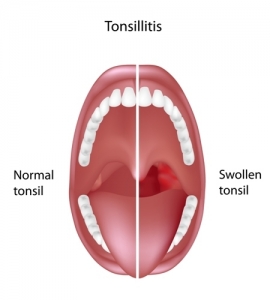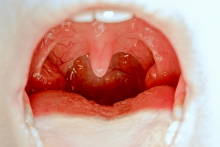Tonsillitis

What are the tonsils and adenoids?
The tonsils are masses of lymphoid tissue on either side of the throat. The adenoid is made of similar tissue and sits at the very back of the nose. Viruses and bacteria that enter the body through the mouth or nose come into contact with the tonsils and adenoids and it is here that the body develops antibodies that make up the body’s immune response to these organisms. After this time, these organs are not essential for life or immunity and can be removed if they are causing problems. The adenoid usually shrinks down before adulthood and as such rarely causes problems for adults.
Tonsillitis

Tonsillitis is inflammation of the tonsils. It can come in many different forms:
Acute Tonsillitis
The most common form and the one most people think of when they hear tonsillitis. The symptoms of this are fever, sore throat, difficulty swallowing, enlarged lymph glands in the neck and bad breath. Acute tonsillitis is usually viral and resolves on its own however it can be bacterial and may require antibiotics
Recurrent Tonsillitis
When acute tonsillitis occurs multiple times in a year then it is classified as recurrent tonsillitis. Depending on the number of infections each year, removal of the tonsils may be the best treatment (see tonsillectomy in adults)
Chronic tonsillitis
Sometimes the infection never goes away completely and you can have a persistent sore throat, bad breath and tender lymph nodes in the neck. This is also an indication for removal of the tonsils
Peritonsillar abscess
Abscess formation around the tonsil sometimes complicates tonsillitis. This is a chance event but if someone suffers a quinsy on more than one occasion then tonsillectomy would be recommended to prevent further episodes
These forms of tonsillitis, along with a number of other reasons, may necessitate you having your tonsils removed. Find out more information on tonsillectomy in adults